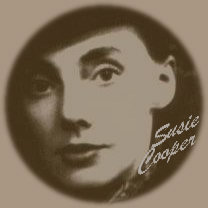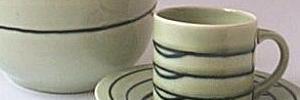
Susie Cooper RDI 1902 - 1995
Born in 1902 in the Stansfield area of Burslem, Stoke on Trent, Susie Cooper's education
eventually found her studying under the influence of Gordon Forsyth, having been awarded a scholarship at the
Burslem School of Art. Intending to pursue a career in fashion, her application to the Royal College of Art,
London was rejected because she was not currently working in a related industry. Gordon Forsyth suggested that
Susie should work for a local potter, A.E.Gray in order to meet the college requirements. In 1922 Susie joined
A.E.Gray initially to train as a paintress. however she was soon promoted to resident designer.
A E Gray
In 1923 A.E.Gray launched the Gloria Lustre Range which was developed in
collaboration with Gordon Forsyth. Susie's progress was rapid, alongside the increase in production of bright
hand painted ranges Gray's launched a new factory mark showing a steamship at full speed, and incorporated the
words 'Designed by Susie Cooper.' This trend in designer marks was to become fashionable throughout the potteries
during the 1930's.
Early Years of Independence
With an increased desire to design shapes as well as patterns Susie left Gray's to establish
the 'Susie Cooper pottery' in October 1929. With the help of her family and particularly her brother in law, Susie took
two rooms in a building known as the George Street Pottery, Tunstall. With the help of six paintresses a paint shop and
office were established and then the decoration of pots began.
After three weeks the George Street Pottery was closed by the owners creditors, so Susie was
forced to relocate. It was March 1930 before They managed to find suitable premises. This time the chosen site was the
Chelsea Works a small pottery in Moorland Road, Burslem.
Chelsea Works and Crown Works
Keen to resume production, Susie initially bought in white ware for decorating from various manufacturers,
blacking out their factory marks and adding her own. (Susie Cooper Productions enclosed in a triangle and rubber-stamped in black.)
Demand for Susie Cooper ware grew steadily and despite taking on extra staff, it became necessary to find larger premises. Wood &
Sons of Burslem could provide Susie with the best quality white-ware that she required and at a reasonable price. With this in mind,
it was decided that it would be advantageous to move Susie Cooper Productions to premises adjacent to Wood's factory. This move into
her famous 'Crown Works' took place in August 1931.
The bulk of her production during these early years reflected the tastes of the times, bright floral's,
geometric and modernist designs in bold hand painted colours. The first shapes designed by Susie as an independent appeared in 1930
with the assistance of Wood & Sons and around the same time the triangle mark was replaced by the Leaping Deer version which has
become the most commonly associated mark with her work.
This was a time of expansion for Susie, productivity was high, new shapes were being introduced, lithograph patterns were
developed, heralding a move away from predominately hand painted wares. In 1932 the Kestrel shape was launched, and a range of studio
pieces was added to her range. 1933 saw developments in crayon decoration and 1935 saw the introduction of her most famous lithograph
pattern, 'Dresden Spray.'
The War Years
1939 brought the outbreak of the Second World War and with it constraints on the production of pottery. Production
became almost impossible in May 1942 when a fire swept through Crown Works destroying Susie's stock of lithographs. The factory was closed as a result.
It was 1945 before the factory re-opened
The re-opening of the factory brought new challenges. The fire had severely damaged her stock of lithographs
and the rationing of building materials made refurbishment difficult. Similar restrictions on supplies of materials also meant that
producing new lithographs to use was also limited, so Susie returned to pre-war decorating techniques to increase production. Hand
painting, mainly under glaze, aerographed and sgraffito decoration all re-appeared, however the colours were more subdued than pre-war
equivalents, and organic or plant forms provided the inspiration for her work.
China Revolution
In June 1950 it was announced that Susie Cooper had acquired a bone china manufacturer. Until now Susie's'
production had been restricted to earthenware. She soon set about designing new shapes for this manufacturing process. The resulting
"Quail shape is possibly the most elegant shape Susie designed. This fresh and curvaceous shape was embellished with subtle sgraffito
scrolls, circles and dots on an aerographed body. The most flamboyant of her designs to be produced in this style are the "Lion and
Unicorn" patterns issued for the Royal Pavilion at the 1951 Festival of Britain.
A second fire at Crown Works in March 1957 brought about another loss of production which took a year to recover
from. Little in the way of new patterns appeared during this time.
Keen to repeat in bone china what she had achieved in earthenware, Susie sought to produce a range of dinnerware.
A merger with R.H. & S.L. Plant in 1958, a family whom Susie had been friends with for many years, gave her access to a tunnel
oven which made the mass production of flatware possible. All bone china production was moved to the Plants' factory, while Susie's own
bone china works was sold off. Meanwhile Crown Works remained the hub of Susie Cooper Productions
Wedgwood
By the mid 1960's the Plant family had concerns about their personal financial position and when in 1966
Wedgwood made a take over bid, the offer proved too good to ignore. Plants' sold their share in the partnership and the company,
along with Susie Cooper, became part of the Wedgwood Group. At first Wedgwood continued production of Susie's designs, in particular
"Black Fruits" and "Glen Mist." They also continued production of the "Can" shape which Susie designed in 1958. The initial reaction
to the merger was one of optimism: the merger released Susie from factory management responsibilities, allowing more time for
designing. Wedgwood were also pleased with their acquisition adding the words "Susie Cooper Design" to the famous Portland vase
factory mark when appropriate.
Susie worked with Wedgwood through the 1960's and 70's during which time distinct patterns like "Carnaby
Daisy," a bright harlequin set based on a simple daisy design, and the vibrant red "Cornpoppy" pattern were amongst her successes.
Despite these triumphs Susie faced an increasing struggle with the corporate structure of Wedgwood and the restrictions this placed
on getting things into production. Matters were not helped by the death of her husband in March 1972. Two months later Susie resigned
her position as a director and operated solely as a designer.
Twilight Years
Recession in 1979 brought about the closure, by Wedgwood, of her beloved Crown Works. Susie moved her design
studio to Adams & Sons (also part of the Wedgwood Group) and continued to work from there, until her move to the Isle of Man in
1986. From here she continued to work as a free-lance designer.
Susie Cooper died on 28th July 1995.
The immense and diverse range of patterns that She designed have left the collector with a wonderful choice of areas to collect,
early art Deco hand painted ware from the Grays period, her rare and elusive early independent productions, fresh floral lithographs of
the mid 1930's, post-war sgraffito and bone china, or her work while with Wedgwood, the choice is vast.

